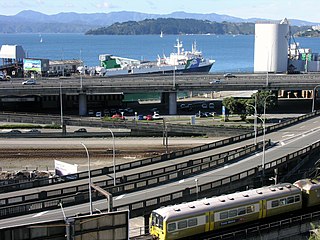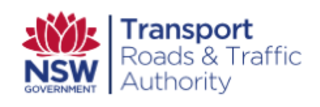Related Research Articles

Transport in New Zealand, with its mountainous topography and a relatively small population mostly located near its long coastline, has always faced many challenges. Before Europeans arrived, Māori either walked or used watercraft on rivers or along the coasts. Later on, European shipping and railways revolutionised the way of transporting goods and people, before being themselves overtaken by road and air, which are nowadays the dominant forms of transport. However, bulk freight still continues to be transported by coastal shipping and by rail transport, and there are attempts to (re)introduce public transport as a major transport mode in the larger population centres.

The Auckland Harbour Bridge is an eight-lane motorway bridge over the Waitematā Harbour in Auckland, New Zealand. It joins St Marys Bay on the Auckland city side with Northcote on the North Shore side. It is part of State Highway 1 and the Auckland Northern Motorway. The bridge is operated by the NZ Transport Agency (NZTA). It is the second-longest road bridge in New Zealand, and the longest in the North Island.

The Roads & Traffic Authority (RTA) was an agency of the New South Wales Government responsible for major road infrastructure, licensing of drivers, and registration of motor vehicles. The RTA directly managed state roads and provided funding to local councils for regional and local roads. In addition, with assistance from the federal government, the RTA also managed the NSW national highway system. The agency was abolished in 2011 and replaced by New South Wales Roads and Maritime Services.

Emergency vehicle lighting is one or more visual warning lights fitted to a vehicle for use when the driver wishes to convey to other road users the urgency of their journey, to provide additional warning of a hazard when stationary, or in the case of law enforcement as a means of signalling another driver to stop for interaction with an officer. These lights may be dedicated emergency lights, such as a beacon or a light bar, or may be modified stock lighting, such as a wig-wag or hide-away light, and are additional to any standard lighting on the car such as hazard lights. Often, they are used along with a siren in order to increase their effectiveness.
The New Zealand Fire Service was New Zealand's main firefighting body from 1 April 1976 until 1 July 2017 – at which point it was dissolved and incorporated into the new Fire and Emergency New Zealand.

The Queen's Gallantry Medal (QGM) is a United Kingdom decoration awarded for exemplary acts of bravery by civilians, and by members of the Armed Forces "not in the face of the enemy", where the services were not so outstanding as to merit the George Cross or the George Medal, but above the level required for the Queen's Commendation for Bravery.
Transport in Auckland, New Zealand's largest city, is defined by factors that include the shape of the Auckland isthmus, the suburban character of much of the urban area, a history of focusing investment on roading projects rather than public transport, and high car-ownership rates.

Grafton Bridge is a road bridge spanning Grafton Gully in Auckland, New Zealand. Built of reinforced concrete in 1910, it connects the Auckland CBD and Karangahape Road with Grafton. It spans about 97.6 metres (320 feet), rises 25.6 metres (84 feet) above the abutments to a height of around 43 metres (142 feet) over the gully. When the bridge was constructed, it contained the largest reinforced concrete arch in the world.

The Auckland Northern Motorway in the Auckland Region of New Zealand links Central Auckland and Puhoi in the former Rodney District via the Hibiscus Coast and North Shore. It is part of State Highway 1.
The 1991 New Zealand bravery awards were announced via a Special Honours List dated 19 December 1991. Twelve of the 33 recipients were recognised for acts of bravery during the Aramoana Massacre on 13 November 1990.
The 1968 Queen's Birthday Honours in New Zealand, celebrating the official birthday of Elizabeth II, were appointments made by the Queen on the advice of the New Zealand government to various orders and honours to reward and highlight good works by New Zealanders. They were announced on 8 June 1968.
The 1987 New Zealand bravery awards were announced via a Special Honours List on 27 August 1987, and recognised ten people for acts of bravery between 1984 and 1986.
The 2007 New Zealand gallantry awards were announced via a Special Honours List on 2 July 2007, and recognised four New Zealand military personnel for actions while serving in Afghanistan in 2004. The identities of three of the four award recipients were not released for operational security reasons. Willie Apiata was awarded the Victoria Cross for New Zealand, the first and so far only time the decoration has been awarded since its inception in 1999.
The 1980 New Zealand bravery awards were announced via a Special Honours List on 23 December 1980, and recognised five people for acts of bravery in 1979 or 1980.
The 1978 New Zealand bravery awards were announced via four Special Honours Lists dated 20 April, 18 May, 13 July, and 2 November 1978, and recognised six people for acts of bravery in 1977 or 1978.
The 1977 New Zealand bravery awards were announced in conjunction with the Queen's Silver Jubilee and Birthday Honours on 11 June 1977, and via a Special Honours List dated 22 December 1977, and recognised ten people for acts of bravery in 1976 and 1977.
The 1975 New Zealand bravery awards were announced via a Special Honours List dated 27 June 1975, and recognised three people for acts of bravery earlier that year.
The 1999 New Zealand bravery awards were announced via a special honours list on 23 October 1999. The awards recognised 30 people, including six posthumously, for acts of bravery between 1989 and 1998.
The 2006 New Zealand bravery awards were announced via a special honours list on 14 October 2006, and recognised 15 people for acts of bravery between 2000 and 2005.
The 2005 New Zealand bravery awards were announced via a special honours list on 29 January 2005, and recognised 26 people, including four posthumously, for acts of bravery between 1999 and 2004.
References
- ↑ "Honours and awards" (PDF). New Zealand Gazette. No. 232. 13 December 1984. pp. 5561–5562.
- ↑ "Honours and awards" (PDF). New Zealand Gazette. No. 94. 23 May 1985. p. 2239.